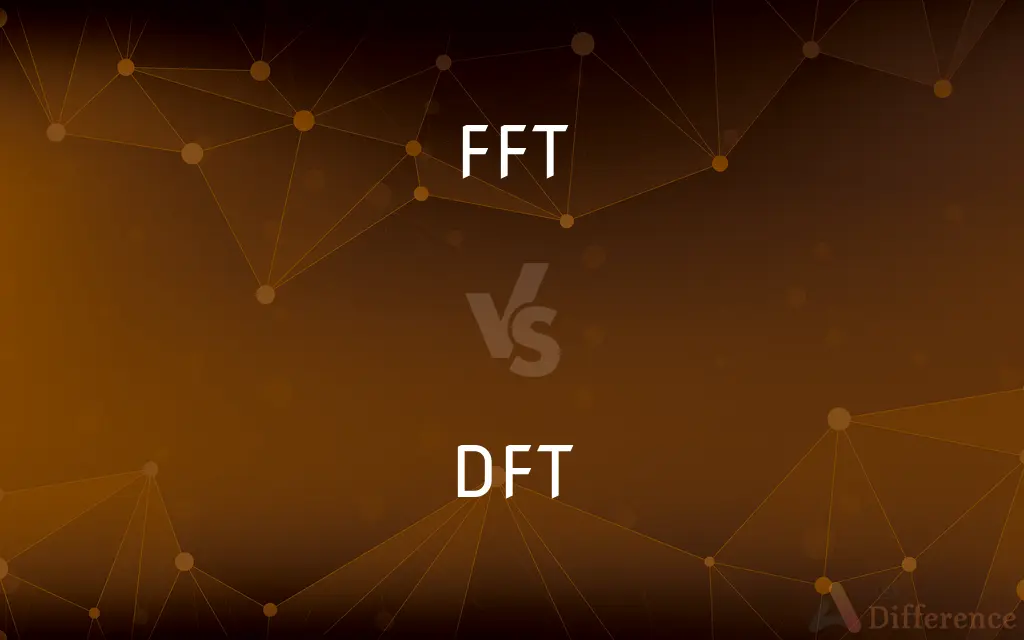FFT vs. DFT — What's the Difference?
Edited by Tayyaba Rehman — By Fiza Rafique — Published on December 26, 2023
FFT is an algorithm to compute DFT; DFT is a transformation of data from time to frequency domain.

Difference Between FFT and DFT
Table of Contents
ADVERTISEMENT
Key Differences
FFT (Fast Fourier Transform) is a computational algorithm designed to speed up and simplify the process of obtaining a Discrete Fourier Transform (DFT). It takes advantage of certain symmetries in the DFT to perform the same operations more quickly. DFT, on the other hand, is a mathematical transform used to convert a sequence of numbers (often time-domain samples) into components of different frequencies.
The DFT is a principle, while the FFT is an implementation of this principle. Another distinction is that while FFT is used primarily because of its efficiency in computing the DFT, the DFT itself is used because it provides valuable information about the frequency content of a signal or dataset.
It's important to note that FFT produces the same result as the DFT; it just does it more quickly. In essence, FFT is a faster method of computing DFT, which provides valuable insights into the frequency domain of signals.
Comparison Chart
Nature
An algorithm
A mathematical transform
Purpose
Speed up computation
Convert time-domain samples to frequency domain
ADVERTISEMENT
Output
Gives DFT result
Frequency components of a signal
Complexity
More efficient (O(N log N) for typical implementations)
Less efficient (O(N^2))
Application
When rapid computation is needed
Fundamental understanding of frequency content
Compare with Definitions
FFT
A quick transform from time to frequency domain.
For rapid insights into sound samples, FFT is a preferred choice.
DFT
An analysis revealing spectral content of signals.
After performing a DFT, it was clear where the noise originated in the circuit.
FFT
A specific technique for DFT calculation.
Using FFT, she completed the analysis in a fraction of the expected time.
DFT
A transform converting time-domain data to frequency domain.
By applying the DFT, we can visualize the main frequencies in this music track.
FFT
A fast approach to spectral analysis.
By applying FFT, they efficiently isolated the problematic frequencies.
DFT
A mathematical representation of frequency components.
The DFT showcased peaks at the fundamental and harmonic frequencies.
FFT
An algorithm to expedite the DFT computation.
The engineer used the FFT to quickly analyze the signal's frequency components.
DFT
A breakdown of time samples into their frequency equivalents.
The DFT provided insights that time-domain analysis alone couldn't offer.
FFT
An optimization for discrete Fourier analysis.
The FFT method made real-time analysis possible.
DFT
A tool to dissect signals into their sinusoidal components.
Through the DFT, the radio engineer pinpointed the interference sources.
Common Curiosities
Can FFT and DFT give different results?
No, FFT gives the same result as DFT; it just computes it more quickly.
What is the primary difference between FFT and DFT?
FFT is an algorithm to compute DFT rapidly, while DFT is a transformation from time to frequency domain.
What is the computational complexity of FFT?
The computational complexity of typical FFT implementations is O(N log N).
What does FFT stand for?
FFT stands for Fast Fourier Transform.
Why is FFT more efficient than DFT?
FFT takes advantage of certain symmetries in the DFT, allowing for faster computation.
Is DFT always replaced by FFT in practical applications?
Not always, but FFT is often preferred due to its computational efficiency.
What is the primary application of DFT?
DFT is used to convert a sequence of numbers (often time-domain samples) into components of different frequencies.
Are FFT and DFT related to Fourier Series?
Yes, both FFT and DFT are discrete versions and computational methods related to the continuous Fourier Series.
What does DFT stand for?
DFT stands for Discrete Fourier Transform.
Can I use DFT to analyze the frequency content of a signal?
Yes, DFT provides valuable insights into the frequency content of signals.
What is the computational complexity of DFT?
The computational complexity of DFT is O(N^2).
Share Your Discovery

Previous Comparison
Hair Dryer vs. Heat Gun
Next Comparison
English Sonnet vs. Italian SonnetAuthor Spotlight
Written by
Fiza RafiqueFiza Rafique is a skilled content writer at AskDifference.com, where she meticulously refines and enhances written pieces. Drawing from her vast editorial expertise, Fiza ensures clarity, accuracy, and precision in every article. Passionate about language, she continually seeks to elevate the quality of content for readers worldwide.
Edited by
Tayyaba RehmanTayyaba Rehman is a distinguished writer, currently serving as a primary contributor to askdifference.com. As a researcher in semantics and etymology, Tayyaba's passion for the complexity of languages and their distinctions has found a perfect home on the platform. Tayyaba delves into the intricacies of language, distinguishing between commonly confused words and phrases, thereby providing clarity for readers worldwide.
















































